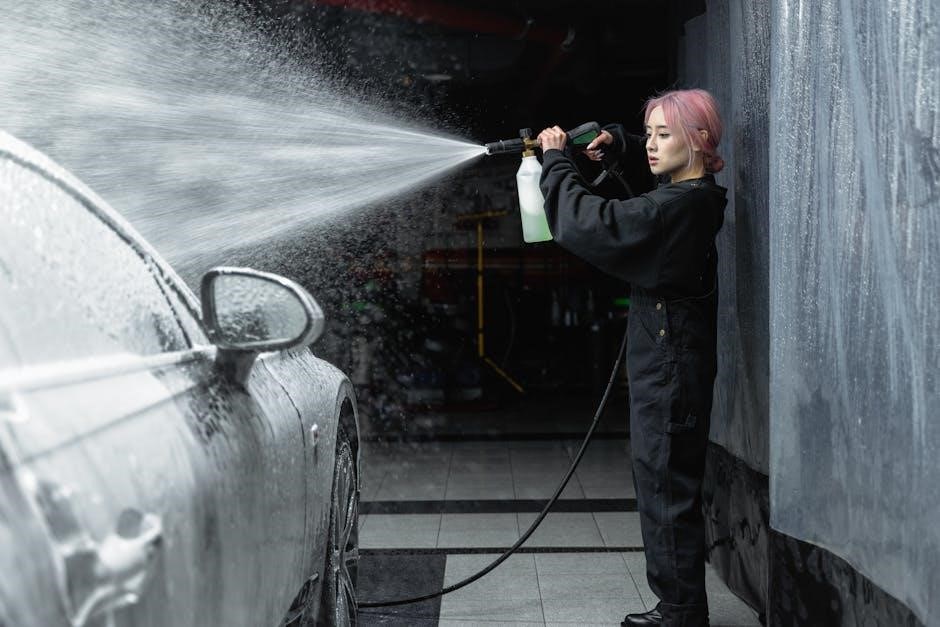Is your Bosch washing machine acting up? This guide helps you diagnose and fix common issues. From error codes to drainage problems‚ we cover it all. Find solutions and maintain your machine‚ ensuring optimal performance. Get free advice and repair instructions tailored for Bosch washers.
Understanding Common Error Codes
Bosch washing machines‚ known for their efficiency‚ sometimes display error codes. These codes signal specific problems‚ aiding in quick diagnosis and repair. Recognizing these codes is the first step in troubleshooting. Error codes appear on the display panel‚ indicating issues like drainage problems or motor malfunctions. Understanding these codes prevents unnecessary service calls.
Common error codes include those related to water drainage‚ water inlet‚ and motor issues. For instance‚ the E18 error often relates to drainage problems‚ while others might indicate pump failure or control module malfunctions. By consulting your user manual‚ you can decipher the meaning of each code.
Error codes save time and money by pointing you to the source of the problem. Before seeking professional help‚ check online resources or DIY guides for solutions associated with the displayed error code. Correctly interpreting the error code allows for targeted troubleshooting‚ whether it’s clearing a blockage or addressing a faulty component. Always refer to reliable sources for accurate interpretations.
E18 Error: Causes and Solutions
The E18 error on a Bosch washing machine typically indicates a drainage problem. This means the machine isn’t successfully emptying water after a wash cycle. Several factors can cause this issue‚ including blockages in the drain pump‚ drain hose‚ or filter. Identifying the root cause is crucial for effectively resolving the E18 error.
One common cause is a clogged drain pump filter. This filter traps debris like lint‚ hair‚ and small objects‚ preventing them from entering the pump. Over time‚ this buildup can restrict water flow‚ triggering the E18 error. Another potential cause is a kinked or blocked drain hose‚ hindering proper drainage.
To resolve the E18 error‚ start by cleaning the drain pump filter. Access it through the small door at the bottom front of the machine. Remove any debris and ensure the impeller spins freely. Next‚ inspect the drain hose for kinks or blockages. Straighten any kinks and clear any obstructions. If the error persists‚ the drain pump itself may be faulty and require replacement. Always consult your user manual for specific instructions.
Addressing Drainage Problems
Effective drainage is essential for a washing machine’s proper functioning. When your Bosch washing machine struggles to drain water‚ it can lead to various issues‚ including error codes and incomplete wash cycles. Addressing these problems promptly is vital to prevent further damage and ensure optimal performance.
Several factors can contribute to drainage problems in your Bosch washing machine. A common culprit is a clogged drain pump filter. This filter‚ designed to trap debris‚ can become overwhelmed with lint‚ hair‚ and small objects‚ restricting water flow. A kinked or blocked drain hose can also impede drainage‚ preventing water from exiting the machine.
To troubleshoot drainage issues‚ begin by inspecting the drain pump filter. Locate the filter access panel‚ usually at the bottom front of the machine‚ and carefully remove the filter. Clean it thoroughly‚ removing any accumulated debris. Next‚ examine the drain hose for kinks‚ bends‚ or obstructions. Straighten the hose and clear any blockages. If the problem persists‚ the drain pump itself may be faulty‚ requiring professional attention. Always refer to your Bosch washing machine’s manual for detailed instructions.
Troubleshooting Blockages

Blockages are a frequent cause of malfunctions in Bosch washing machines‚ impacting their ability to function efficiently. These obstructions can occur in various parts of the machine‚ leading to issues like poor drainage‚ unusual noises‚ or even complete operational failure. Identifying and resolving these blockages is crucial for maintaining your washing machine’s performance.
One common area for blockages is the drain pump filter. This filter is designed to catch lint‚ hair‚ and small objects‚ preventing them from entering the drain pump and causing damage. However‚ over time‚ this filter can become clogged‚ restricting water flow and leading to drainage problems. Regularly cleaning the drain pump filter is essential for preventing blockages.
Another potential location for blockages is the drain hose. This hose can become kinked or obstructed‚ preventing water from draining properly. Inspect the drain hose for any visible kinks or bends‚ and ensure that it is not crushed or blocked by any objects. Additionally‚ the internal components of the washing machine‚ such as the pump or impeller‚ can also become blocked by debris. If you suspect a blockage in these areas‚ it is best to consult a qualified technician.

Dealing with Unusual Noises and Vibrations
Unusual noises and excessive vibrations during a wash cycle can indicate underlying problems with your Bosch washing machine. While some noise is normal‚ loud banging‚ grinding‚ or excessive shaking should not be ignored. Identifying the source of these disturbances is crucial for preventing further damage and ensuring optimal performance.
One common cause of unusual noises and vibrations is an unbalanced load. If the laundry is not distributed evenly inside the drum‚ it can cause the machine to shake violently during the spin cycle. Redistribute the load to ensure that the items are balanced. Another potential cause is worn-out or damaged shock absorbers. These components help to dampen vibrations and keep the machine stable. If the shock absorbers are failing‚ they may need to be replaced.
Additionally‚ loose or damaged components‚ such as the motor or pump‚ can also cause unusual noises and vibrations. Inspect these components for any signs of wear or damage. Furthermore‚ foreign objects‚ such as coins or buttons‚ can become trapped inside the drum or pump‚ causing rattling or grinding noises. Remove any foreign objects that you find.
Fixing a Washing Machine That Won’t Turn On
A washing machine that refuses to power on can be frustrating‚ disrupting your laundry routine. Several factors can cause this issue‚ ranging from simple fixes to more complex problems requiring professional assistance. Before calling a technician‚ it’s wise to investigate a few potential causes.

First‚ ensure the washing machine is properly plugged into a functioning power outlet. Test the outlet with another appliance to confirm it’s providing electricity. Check the circuit breaker or fuse box to see if the circuit has tripped or the fuse has blown. Reset the breaker or replace the fuse if necessary.
Examine the power cord for any signs of damage‚ such as cuts or fraying. If the cord is damaged‚ it should be replaced by a qualified technician. Next‚ verify that the washing machine’s door or lid is fully closed and latched. Most machines have a safety switch that prevents them from starting if the door is not securely closed. A faulty door switch can also prevent the machine from turning on‚ even if the door is closed. Finally‚ consult your user manual for specific troubleshooting steps related to power issues.
Diagnosing Spin Cycle Issues
A malfunctioning spin cycle can leave your clothes soaking wet‚ prolonging the laundry process. Several factors can contribute to spin cycle problems in Bosch washing machines. Let’s explore some common causes and troubleshooting steps.
First‚ ensure the washing machine is not overloaded. Overloading can prevent the drum from spinning properly; Remove some items and try running the spin cycle again. Check the drain hose for any kinks or blockages. A blocked drain hose can prevent water from draining‚ which is necessary for the spin cycle to function. Inspect the drain pump filter for debris and clean it if necessary.

A worn-out drive belt can also cause spin cycle issues. The drive belt connects the motor to the drum‚ and if it’s loose or broken‚ the drum may not spin effectively. Examine the motor brushes for wear and tear. Worn brushes can reduce the motor’s power‚ affecting the spin cycle. If the above steps don’t resolve the issue‚ the problem might lie with the control module. A malfunctioning control module can disrupt the spin cycle’s operation. Consult your user manual for troubleshooting steps or consider contacting a qualified technician.
Cleaning and Maintenance Tips
Regular cleaning and maintenance are crucial for prolonging the life of your Bosch washing machine and ensuring optimal performance. A clean washing machine operates more efficiently and prevents unpleasant odors and residue buildup.
Start by cleaning the detergent dispenser regularly. Residue from detergents and fabric softeners can accumulate‚ leading to clogs and reduced effectiveness. Rinse the dispenser with warm water and wipe it clean. Next‚ clean the rubber door seal. This area is prone to mold and mildew growth. Wipe the seal with a damp cloth and a mild cleaning solution after each wash. Periodically run a cleaning cycle with a washing machine cleaner to remove buildup and sanitize the machine. Bosch offers specialized cleaning products for this purpose.
Clean the drain pump filter regularly to prevent blockages. The filter traps lint‚ debris‚ and small objects. Refer to your user manual for instructions on accessing and cleaning the filter. Inspect the water inlet hoses for any signs of wear or damage. Replace them if necessary to prevent leaks. Lastly‚ leave the washing machine door slightly ajar after each use to allow air circulation and prevent moisture buildup. These simple steps will help keep your Bosch washing machine clean and running smoothly for years to come.
Locating Repair Manuals and DIY Resources
Finding the right repair manual and DIY resources is essential when tackling Bosch washing machine repairs yourself. Start by checking the Bosch website for your specific model. Bosch typically provides downloadable user manuals that include troubleshooting sections and basic repair information. These manuals often contain error code explanations‚ diagrams‚ and step-by-step instructions for common issues.
If you can’t find the manual on the Bosch website‚ try searching online appliance repair forums and communities. These forums are a great source of information and often have experienced users who can provide advice and guidance. Websites like ApplianceRepair.com and RepairClinic.com offer repair manuals‚ schematics‚ and troubleshooting guides for various Bosch models. YouTube is another valuable resource for DIY repair videos. Many channels feature step-by-step tutorials on fixing common washing machine problems.
When searching for resources‚ be sure to have your washing machine’s model number handy. This will ensure you find the correct information for your specific machine. Remember to exercise caution when attempting DIY repairs and always disconnect the power before working on any electrical components. With the right resources‚ you can confidently troubleshoot and repair your Bosch washing machine.
